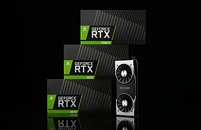Thursday, November 22nd 2018

NVIDIA GeForce RTX 2060 Shows Up in Final Fantasy XV Benchmarks
The RTX family debuted with top of the line graphics cards, but the Turing era is just started and there will be new members joining those first products. One of the most expected is the RTX 2060, and now this new graphics card has been seen in Final Fantasy XV benchmarking database. This information should be taken with a grain of salt, but in the past this listing has showed us upcoming products such as the Radeon RX 590, so the evidence is quite interesting. According to this data, the RTX 2060 would perform slightly below the Radeon RX Vega 56 and NVIDIA GeForce GTX 1070, but its numbers are quite better than those of the GTX 1060.
NVIDIA itself confirmed there would be a "mainstream" product in the Turing family in the future, and although the company seems now focused on selling out their excess inventory of mid-range Pascal graphics cards -Black Friday could help there-, the new GPU could be announced in the next few weeks and some analysts expect it to be available on Q1 2019. It'll be interesting to confirm if the data in our TPU database is correct, but we're specially curious about the price point it'll have.
Source:
Overclock 3D
NVIDIA itself confirmed there would be a "mainstream" product in the Turing family in the future, and although the company seems now focused on selling out their excess inventory of mid-range Pascal graphics cards -Black Friday could help there-, the new GPU could be announced in the next few weeks and some analysts expect it to be available on Q1 2019. It'll be interesting to confirm if the data in our TPU database is correct, but we're specially curious about the price point it'll have.


121 Comments on NVIDIA GeForce RTX 2060 Shows Up in Final Fantasy XV Benchmarks
The issue happens with presets AFAIK (needs hairworks). Regardless, I just showed what the hullabaloo was about. ;)
You arent running this as an analog for the fps in game, so there isnt a worry. It's still a crappy bench for those reasons, however. Again, just sharing what it the issues are since it was brought up. :)
Im not seeing it when 7nm might be the last big step forward.
wait until more games are implemented with RTX which they will. and then we can figure out where this leads, until then this is exactly what we needed to move on.
RTX is far from an invalid idea or tech.the benchmark works as intended.
From looking at the disastrous implementation in Battlefield V, it becomes obvious to me that simulating mostly specular reflections on selected objects becomes pretty useless and creates more visual problems than it solves. Clearly, a game engine built from the ground up around this technology would do it better, but I still think they chose the wrong approach. I would start by doing the diffuse global illumination primarily, this will get the overall lighting and soft shadows right with great visual improvements. Then, I would do specular reflections fairly softly, because most surfaces are generally not highly reflective. This way, raytracing can become useful without requiring unobtainable computational performance. And with these considerations in mind, I do believe some games could make good use of the performance level RTX 2080 Ti offers.
You're right that 7 nm might be the last "good shrink", while there will certainly be new techniques pushing transistor counts in the future, the progress beyond this will be much slower than the last few decades. The days of "easy" expansions of GPUs is pretty much passed. This means it's up to GPU makers to make the hardware more efficient, and game developers to utilize this hardware more efficiently.
How ever this reminds me of PhysX where u needed a separate card to get good performance before the 400 series.we are moving in the right direction regardless of how long it takes
Edit: and like i said the only issue is the pricing at which nvidia chose to adopt this in with its msrp.
I'm just saying that raytracing is not flawed because of a bad demonstration, and we should not dismiss Nvidia's groundwork here. This is only the beginning.
To make an analogy; Direct3D 10 was not bad despite Crysis being a flawed game…
I'll refer you to every other tech that required specific, dedicated dev time. It takes a very, very solid business case to even remotely start that kind of work. Where is that business case? Just an analysis: there isn't one, as long as RTRT isn't available in all but the slowest of GPUs. So that 2080ti performance, right now, for the adoption of RTX, means absolutely nothing at all. There IS no adoption rate as long as this is the price point it requires. And I think everyone can agree that the lower tier GPUs offer unacceptable performance.
I agree there are quite possibly many tweaks and improvements to be made, no doubt about it. But in the same way, we had high hopes for DX12 features like mGPU. How's that going? Its another one of those time- and configuration-heavy implementations with questionable benefits that only touch a minority of the gaming market. Again: there was no business case to be made for it, and look where mGPU is at today.
There are so many parallels with failed technologies its unreal. The inability to recognize that, to me, is a dangerous form of blindness. This is NOT the same as hardware T&L or anything like that. The timeframe isn't the same, the industry support isn't the same, and the demand for such a tech is radically different. We will always chase photo-realism in digital content, and yes, RT can be a means to this end. But somehow, ever since Nvidia said this was a holy grail, we seem to have forgotten there were very, very good reasons to take a different approach than brute forcing everything, because that is what RTRT really means, no matter how you optimize it. RTRT will ALWAYS be in competition with cheaper tech that gets very similar results and is supported everywhere.
In the end, the only viable developments in any kind of product depend on the price they can be sold at. Look at Elon Musk, and his plans to colonize Mars, and how the very core of everything he plans is based on the cost of that return trip, and bringing it down to a reasonable level. If there is no profitability, it will die - if you cannot bring a development to the masses, it will die.
if there is one thing this industry (gaming) has shown us the last ten years, it is a steady trend towards the 'one-size-fits-all' method of development. Consoles moved to x86. Most of the games are ported back and forth. Exclusives are rapidly drying up compared to previous gen. Everything is aimed at maximizing profit while minimizing development time before a product is rushed out the door, only to incrementally fix it afterwards with a much smaller team. That is not the landscape where RTRT will be able to flourish. Its one of those items on a loooong list of 'nice-to-haves' in software development. And it sure as hell isn't on the top of that list.
BTW; My car stops being reflective after one trip.:(</off_topic>
I even use Autoglym High Defenition wax to avoid pixelation on my car…
Really, there are only a few studios/publishers that I think are capable enough (fiscal freedom, creative freedom, talent?) to implement this with enough efficiency improvements to make RTRT even remotely viable for this gen: Epic, CDPR, Ubisoft, and I was going to say DICE but...we saw how that worked out.
On top of that, there will be a nearly subatomic level audience that will even be able to use RTRT as only the 2080+ levels will have the grunt to do it. Until there is 2080ti levels of RTRT processing on the 2060 at a sub $300USD, there will be little work put in by anyone outside of nVidia. That may even be next gen but seeing what we have already seen, I suspect that Star Citizen has an equal chance of launching first.I mean, I don't believe that nVidia threw DICE some manuals about DXR 3 days before launch. I would be willing to bet that nVidia was working hand in hand with Dice for many, many, months on this implementation and everyone can agree it was less than impressive.I would have hoped that the devs and nVidia would have figured out the optimum approach for implementing RTRT to show it's value and provide a path forward instead of this...mess. The work now has to be to fixing what they have already done which will still make the game look like it has been sprayed with clear coat. They certainly can't go backwards and remove that and implement the low hanging fruit per se. Maybe it's just me but I haven't really seen anything that strikes me as this looks awesome and I can't wait to have it. I am sure it will come but I'll probably be playing Star Citizen.
I equate it to trying to hit a grand slam with the bases loaded and striking out instead of just shooting for a base hit to drive some runs in.
RTX has been on the market for a massive 2 months, I think we can give them some time…
The big announcements were august
and the 970 itself is quite a bit faster than the gtx 780
with that in mind we should expect the RTX 2060 to at least outperform the gtx 1070
Large software projects are done in phases, and adding new major features in the last testing phases is a bad idea. Even if they have the best people in the industry, doing major rewrites are not done over night. But this kind of stuff is typical when non-technical people are in charge. I feel sorry for the poor coders…